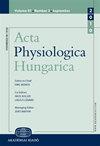The effects of intermittent hypoxia training on hematological and aerobic performance in triathletes.
引用次数: 10
Abstract
The aim of the present research was to analyze modifications on hematological and aerobic performance parameters after a 7-week intermittent hypoxia training (IHT) program. Eighteen male trained triathletes were divided in two groups: an intermittent hypoxia training group (IHTG: n: 9; 26.0 ± 6.7 years; 173.3 ± 5.9 cm; 66.4 ± 5.9 kg; VO₂max: 59.5 ± 5.0 ml/kg/min) that conducted a normoxic training plus an IHT and a control group (CG: n: 9; 29.3 ± 6.8 years; 174.9 ± 4.6 cm; 59.7 ± 6.8 kg; VO₂max: 58.9 ± 4.5 ml/kg/min) that performed only a normoxic training. Training process was standardized across the two groups. The IHT program consisted of two 60-min sessions per week at intensities over the anaerobic threshold and atmospheric conditions between 14.5 and 15% FiO₂. Before and after the 7-week training, aerobic performance in an incremental running test and hematological parameters were analyzed. After this training program, the IHTG showed higher hemoglobin and erythrocytes (p < 0.05) values than in the CG. In terms of physiological and performance variables, between the two groups no changes were found. The addition of an IHT program to normoxic training caused an improvement in hematological parameters but aerobic performance and physiological variables compared to similar training under normoxic conditions did not increase.间歇低氧训练对铁人三项运动员血液学和有氧运动的影响。
本研究的目的是分析7周间歇缺氧训练(IHT)后血液学和有氧性能参数的变化。18名男性铁人三项运动员被分为两组:间歇缺氧训练组(IHTG: n: 9;26.0±6.7岁;173.3±5.9 cm;66.4±5.9 kg;VO₂max: 59.5±5.0 ml/kg/min),进行常规训练加IHT和对照组(CG: n: 9;29.3±6.8岁;174.9±4.6 cm;59.7±6.8 kg;VO₂max: 58.9±4.5 ml/kg/min),只进行常规训练。两组的训练过程是标准化的。IHT计划包括每周两次60分钟的训练,强度超过厌氧阈值,大气条件在14.5至15% FiO₂之间。在7周训练前后,分析增量跑步测试中的有氧表现和血液学参数。训练结束后,IHTG的血红蛋白和红细胞高于CG (p < 0.05)。在生理和性能指标方面,两组之间没有变化。在常氧训练中加入IHT项目可以改善血液学参数,但与常氧条件下的类似训练相比,有氧表现和生理变量并没有增加。
本文章由计算机程序翻译,如有差异,请以英文原文为准。
求助全文
约1分钟内获得全文
求助全文

 求助内容:
求助内容: 应助结果提醒方式:
应助结果提醒方式:


